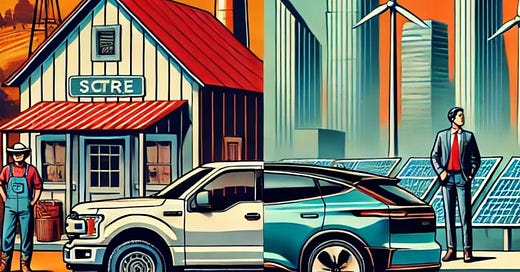The EV Industry’s Affordability Problem: Why Luxury Electric Cars Won’t Drive Mass Adoption
How the industry’s obsession with high-end models is stalling progress—and what it must do to fix it.
The fastest way to stall EV adoption is to continue down the current elitist path. Automakers are doubling down on high-margin, premium electric models while leaving mass-market consumers behind. The strategy makes sense in a boardroom—it pads short-term profits and caters to high-income buyers who can afford new technology. But the long-term consequences are dire: slowing adoption, rising skepticism, and the growing perception that EVs are luxury products for the wealthy rather than viable transportation for the masses.
EVs Remain Out of Reach for Most Buyers
The numbers reveal the extent of the problem. The average price of a new EV in the U.S. sits at $52,345, according to Kelley Blue Book—still thousands higher than the $48,247 average for all new vehicles. Even Tesla, the closest thing to a mass-market EV brand, still prices most of its models well above what an average buyer can afford. While price cuts have improved affordability somewhat, the Tesla Model Y still starts at over $43,000, and many buyers don’t qualify for full tax incentives.
And that tax incentive? It’s likely on borrowed time. The federal EV tax credit—one of the biggest levers making EVs remotely competitive—faces an uncertain future, especially as budget cuts and shifting political winds threaten its long-term viability. Without it, EVs become even less accessible for middle- and lower-income buyers. The moment those incentives disappear, the real cost of EV ownership will become painfully clear for millions of potential buyers.
At the same time, used EVs remain a tiny fraction of the secondary market, and depreciation concerns make them less attractive than comparable internal combustion engine (ICE) vehicles. Consumers who might consider an EV often find that used options either don’t exist in their area or aren’t significantly cheaper than buying new—a stark contrast to the robust and affordable used ICE market.
Infrastructure and Political Divide Are Making Things Worse
Affordability isn't just about sticker prices—it’s about the total cost of ownership, and here, charging infrastructure plays a critical role. Charging networks remain concentrated in wealthy, urban areas, leaving rural and lower-income communities at a significant disadvantage. My recent attempt to fund an EV charging station in rural Florida illustrated this divide firsthand. Bureaucratic delays, nonexistent funding opportunities, and expensive, rapidly depreciating technology made it clear that the much-touted U.S. government multi-billion-dollar investment in charging infrastructure is still more hype than reality. If the goal is universal electrification, then expanding infrastructure beyond high-income zip codes must be a priority.
But infrastructure is just one part of the challenge. The biggest mistake the EV industry continues to make is treating these vehicles as high-end status symbols rather than practical tools. Automakers have prioritized luxury SUVs and high-performance sedans, leaving behind the vehicles that most Americans actually buy—trucks, work vans, and affordable commuter cars. There’s no shortage of $70,000+ EVs with panoramic roofs and self-driving promises, but where is the equivalent of the Honda Civic, Toyota Corolla, or Ford Maverick in an EV form factor? Until those vehicles exist, the EV market will remain niche, rather than mainstream.
This shift toward luxury EVs has created an unintended backlash, turning what should have been a unifying climate initiative into a cultural and economic flashpoint. Government policies like ICE bans and EV mandates have sparked resistance, especially in rural America, where many see electrification efforts as policies designed for urban elites rather than practical solutions for working-class Americans. This divide is only growing. Wyoming made headlines by proposing a bill to ban EVs by 2035—a direct response to California’s plan to phase out gasoline-powered cars in the same timeframe. While largely symbolic, the move illustrates the growing political polarization around EV adoption.
The Industry Needs a Course Correction
And then there’s the issue of profitability. While Tesla has managed to scale production and remain the only EV-first automaker to turn a profit, other companies are struggling. Ford has lost billions on its EV division, slashing prices and slowing its expansion plans in an attempt to match demand. Meanwhile, Toyota, which prioritized hybrids over full electrification, is now significantly outperforming most of its competitors in profitability and sales growth. The lesson here is clear: an aggressive push for EVs at the expense of affordability and practicality is backfiring.
If the industry wants to fix this, it doesn’t need to abandon EVs—it needs to rethink its approach. Instead of pouring billions into marketing EVs as futuristic tech gadgets, automakers need to refocus on practical, attainable electrification. The focus should be on making EVs that are affordable, reliable, and easy to charge in any location—not just in affluent neighborhoods with dedicated charging spots.
A Practical EV Market That Actually Works
The path forward is simple: Build EVs that people can afford even without a tax credit. Invest in charging solutions that serve rural and working-class communities. Shift incentives away from luxury tax breaks and toward making EVs genuinely accessible. And perhaps most importantly, stop assuming that just because something is better on paper, consumers will automatically embrace it.
EV adoption doesn’t need to stall—it just needs to stop looking upmarket and start looking forward.
#ev #sustainablemobility #electricvehicles #evequity #transportationforall #evinfrastructure #greentransportation #futureofmobility




